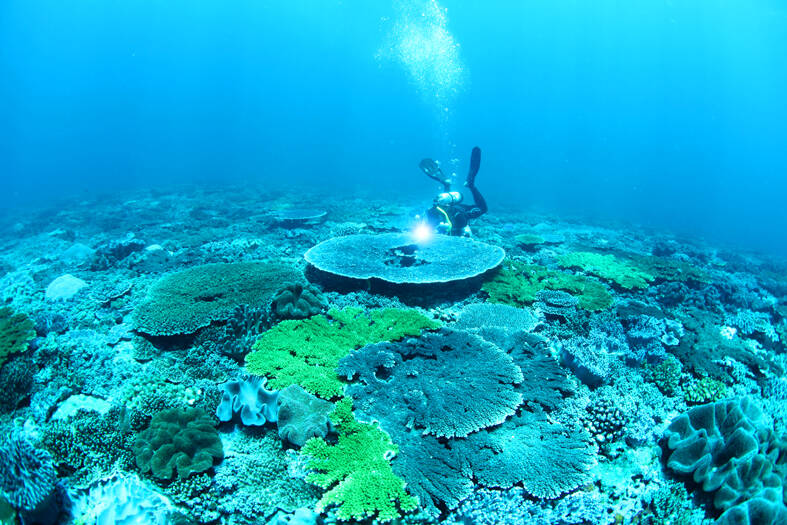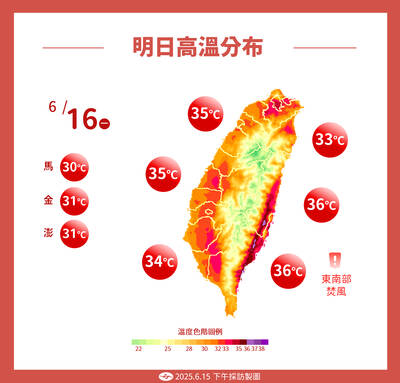The government should adopt a “leave no trace” principle for the Pratas Islands (Dongsha Islands, 東沙群島) if it develops tourism in the protected area, an academic said on Saturday.
The Dongsha Atoll National Park, at the southernmost tip of Taiwan’s territory, is the nation’s first marine national park, consisting of the Pratas Islands. It is nicknamed the “Pearl of the South China Sea.”
The government has in the past few years been rebuilding a port in the atoll at a depth of 4m, which is expected to be completed by the end of this year.

Photo courtesy of Jeng Ming-shiou
Amid growing enthusiasm for diving, the atoll has the potential to become a big tourist attraction for divers, Academia Sinica Biodiversity Research Center chief executive officer Jeng Ming-shiou (鄭明修) said.
To protect the marine environment and ecological systems, trips to the island must be operated on a “leave no trace” principle, following the example of tourism in Antarctica, in which tourists’ food and accommodation would be restricted to the vessel and their garbage would be shipped away, he said.
The national park features the largest seagrass bed among Taiwanese territorial waters, with nine seagrass species, and the Pratas Islands also boast valuable corals that once had a coverage of 60 to 90 percent of the atoll’s lagoon and outer waters, attracting more than 10,000 green sea turtles, Jeng said.
However, much of the coral that inhabited the 300km2 lagoon was bleached and died due to rising water temperatures from an El Nino event in 1998, while the corals surrounding the atoll have been threatened by crown-of-thorns starfish and illegal fishing by Chinese vessels, Jeng said.
Conservation efforts and the Coast Guard Administration’s efforts to clamp down on illegal fishing in the past few years have helped revive the marine environment around the atoll, he said.
While leading a research team to remove crown-of-thorns starfish last year, Jeng found the recovery is striking, adding that pods of dolphins have returned to the atoll, he said.
Divers saw 50 to 60 dolphins and other protected marine species, such as green humphead parrotfish and humphead wrasse, at least 70 of them each, he said.
The return of marine life to the area not only attests to Taiwan’s conservation efforts, but also demonstrates the atoll’s appeal to diving enthusiasts, he added.
When the national park was established in 2007, then-Kaohsiung mayor Frank Hsieh (謝長廷) permitted visits by tourists using a boat that could carry up to 200 passengers, Jeng said.
However, it did not take off, due to the lengthy sailing time and limited land and resources for sightseeing or entertainment, he said.
Diving was not as popular in Taiwan at the time, he said, adding that the trip from Kaohsiung to the island by boat requires about 20 hours, but circling the island by bike takes only 30 minutes.
The situation worsened as the port of the island silted up and could no longer berth vessels, he said.
Coast guard and national park personnel are stationed on the island, along with staff and researchers of the atoll’s international research station, who commute by airplane, Jeng said.

Costa Rica sent a group of intelligence officials to Taiwan for a short-term training program, the first time the Central American country has done so since the countries ended official diplomatic relations in 2007, a Costa Rican media outlet reported last week. Five officials from the Costa Rican Directorate of Intelligence and Security last month spent 23 days in Taipei undergoing a series of training sessions focused on national security, La Nacion reported on Friday, quoting unnamed sources. The Costa Rican government has not confirmed the report. The Chinese embassy in Costa Rica protested the news, saying in a statement issued the same

Taiwan is to extend its visa-waiver program for Philippine passport holders for another year, starting on Aug. 1, Minister of Foreign Affairs Lin Chia-lung (林佳龍) said on Friday. Lin made the announcement during a reception in Taipei marking the 127th anniversary of Philippine independence and the 50th anniversary of the establishment of the Manila Economic and Cultural Office (MECO) in Taiwan, the Ministry of Foreign Affairs said. The decision reflected Taiwan’s commitment to deepening exchanges with the Philippines, the statement cited Lin as saying, adding that it was a key partner under the New Southbound Policy launched in 2016. Lin also expressed hope

Temperatures in New Taipei City’s Sindian District (新店) climbed past 37°C yesterday, as the Central Weather Administration (CWA) issued heat alerts for 16 municipalities, warning the public of intense heat expected across Taiwan. The hottest location in Taiwan was in Sindian, where the mercury reached 37.5°C at about 2pm, according to CWA data. Taipei’s Shilin District (士林) recorded a temperature of 37.4°C at noon, Taitung County’s Jinfeng Township (金峰) at 12:50 pm logged a temperature of 37.4°C and Miaoli County’s Toufen Township (頭份) reached 36.7°C at 11:40am, the CWA said. The weather agency yesterday issued a yellow level information notice for Taipei, New

CASE: Prosecutors have requested heavy sentences, citing a lack of remorse and the defendants’ role in ‘undermining the country’s democratic foundations’ Five people affiliated with the Chinese Nationalist Party (KMT), including senior staff from the party’s Taipei branch, were indicted yesterday for allegedly forging thousands of signatures to recall two Democratic Progressive Party (DPP) lawmakers. Those indicted include KMT Taipei chapter director Huang Lu Chin-ru (黃呂錦茹), secretary-general Chu Wen-ching (初文卿) and secretary Yao Fu-wen (姚富文), the Taipei District Prosecutors’ Office said in a news release. Prosecutors said the three were responsible for fabricating 5,211 signature forms — 2,537 related to the recall of DPP Legislator Wu Pei-yi (吳沛憶) and 2,674 for DPP Legislator Rosalia Wu (吳思瑤) — with forged entries accounting for